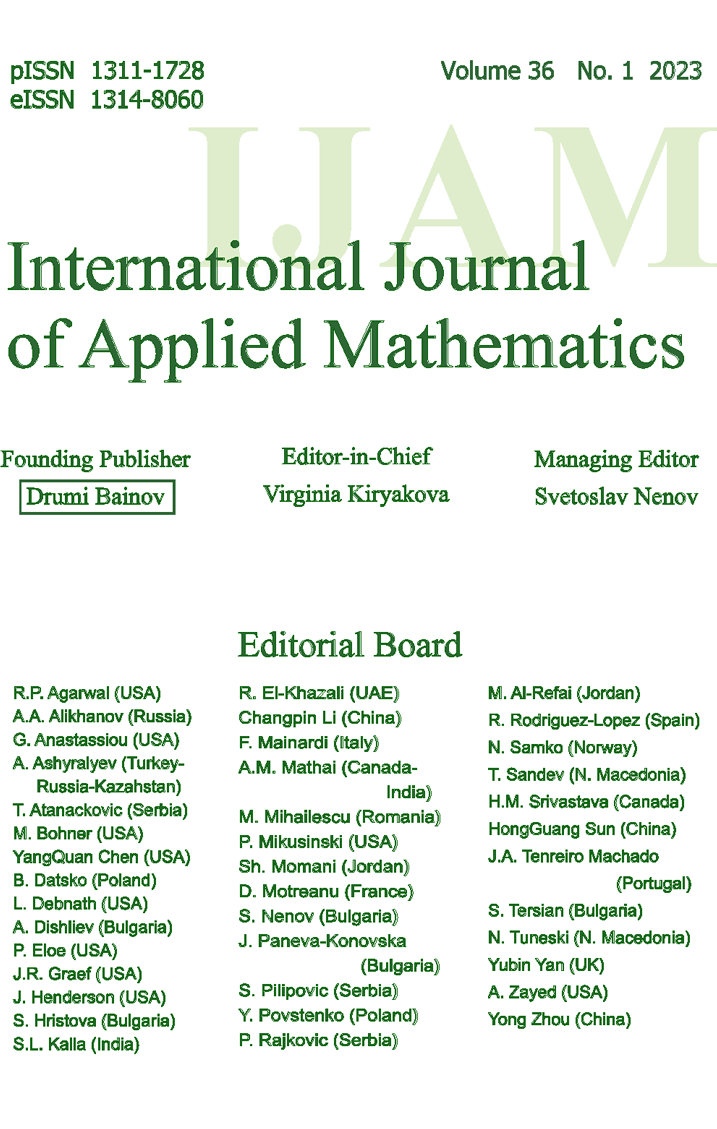CALCULATING THREE THERMAL COEFFICIENTS
FROM ONE DATA SET
FROM ONE DATA SET
Abstract
We study the problem of determining three thermal coefficients from one set data of a model problem rising in thermodynamics. This is an inverse problem, that is to coincide the solution of the differential equation with actual experimental results. The used method is based on minimizing the solution of the problem with the experimental data. Both the direct and inverse problems are described and numerical results are given.Citation details of the article
Journal: International Journal of Applied Mathematics Journal ISSN (Print): ISSN 1311-1728
Journal ISSN (Electronic): ISSN 1314-8060
Volume: 32 Issue: 1 Year: 2019 DOI: 10.12732/ijam.v32i1.9
Download Section
Download the full text of article from here.
You will need Adobe Acrobat reader. For more information and free download of the reader, please follow this link.
References
- [[1] H.E. Kunze, D. La Torre, F. Mendivil, M.R. Galan, R. Zaki, Fractal-based methods and inverse problems for differential equations: Current state-of- the-art, Mathematical Problems in Engineering, 2014 (2014), Article ID 737694, 11 pages.
- [2] L. Dingand, J. Cao, Electromagnetic nondestructive testing by perturbation homotopy method, Mathematical Problems in Engineering, 2014 (2014), Article ID 895159, 10 pages.
- [3] F.M. Hosseini, N. Baddour, A structured approach to solve the inverse eigenvalue problem for a beam with added mass, Mathematical Problems in Engineering, 2014 (2014), Article ID 292609, 12 pages.
- [4] Peng Li and al., Reconstruction of shredded paper documents by feature matching, Mathematical Problems in Engineering, 2014 (2014), Article ID 514748, 9 pages.
- [5] Y. Gao, A. Cao, H. Chen, X. Lv, Estimation of bottom friction coefficients based on an isopycnic-coordinate internal tidal model with adjoint method, Mathematical Problems in Engineering, 2013 (2013), Article ID 532814, 11 pages.
- [6] G. Evensen, Data Assimilation. The Ensemble Kalman Filter, Springer (2009).
- [7] J. Kaipio, E. Somersalo, Statistical and Computational Inverse Problems, Springer (2005).
- [8] H.T. Banks, H.T. Tran, Mathematical and Experimental Modeling of Physical and Biological Processes, Chapman and Hall/CRC 1st Ed., Boca Raton, FL (2009).
- [9] I. Graham, U. Langer, J. Melenk, M. Sini (Eds.), Direct and Inverse Problems in Wave Propagation and Applications, Ser.: Radon Series on Computational and Applied Mathematics, W. De Gruyter (2013).
- [10] A. Kharab, E.G. Wolff, R.B. Guenther, Numerical investigation of an inverse problem in thermodynamics, To appear in: Int. J. of Pure and Appl. Math., 120 (2018).
- [11] A. Kirsch, An Introduction to the Mathematical Theory of Inverse Problems of Applied Mathematical Sciences, 120, Springer, NY, USA (2011).
- [12] F.D. Moura Neto, A.J. da Silva Neto, An Introduction to Inverse Problems with Applications, Springer, New York (2013).
- [13] A. Tarantola, Inverse Problem Theory and Methods for Model Parameter Estimation, SIAM, Philadelphia (2005).
- [14] C.R. Vogel, Computational Methods for Inverse Problems, SIAM, New York (2002).
- [15] H.W. Engl and W. Grever, Using the L-curve for determining optimal regularization parameters, Numerische Mathematik, 69, No 1 (1994), 25– 31.
- [16] Y.L. Keung, J. Zou, An efficient linear solver for nonlinear parameter identification problems, SIAM J. on Scientific Computing, 22, No 5 (2000), 1511–1526.
- [17] J. Li and J. Zou, Amultilevel correction method for parameter identificatio, Inverse Problems, 23 (2007), 1759–1786.
- [18] J. Milstein, The Inverse Problem: Estimation of kinetic parameters, Chapter from: Modelling of Chemical Reaction Systems, Proc. of an International Workshop, Heidelberg, Germany (Sept. 1980).
- [19] A.N. Tychonoff, V.Y. Arsenin, Solution of Ill-Posed Problems, Winston & Sons, Washington, DC (1977).
- [20] M.F. Barnsley, V. Ervin, D. Hardin, J. Lancaster, Solution of an inverse problem for fractals and other sets, Proc. of the National Academy of Sciences of the United States of America, 83, No 7 (1986), 1975–1977.
- [21] B. Forte, E.R. Vrscay, Inverse Problem Methods for Generalized Fractal Transforms in Fractal Image Encoding and Analysis, Y. Fisher, Ed. of NATO ASI Series F 159, Springer, New York, NY (1998).
- [22] H.E. Kunze, J.E. Hicken, E.R. Vrscay, Inverse problems for ODEs using contraction maps and sub optimality of the collage method, Inverse Problems, 20, No 3 (2004), 977–991.
- [23] H.E. Kunze, E.R. Vrscay, Solving inverse problems for ordinary differential equations using the Picard contraction mapping, Inverse Problems, 15, No 3 (1999), 745–770.
- [24] H. Kunze, D. la Torre, E.R. Vrscay, Solving inverse problems for DEs using the collage theorem and entropy maximization, Applied Mathematics Letters, 25, No 12 (2012), 2306–2311.
- [25] H. Kunze, S. Gomes, Solving an inverse problem for Urison-type integral equations using Banach’s fixed point theore, Inverse Problems, 19, No 2 (2003), 411–418.
- [26] M. Levere, H. Kunze, D. La Torre, A collage-based approach to solving inverse problems for second-order nonlinear parabolic PDEs, J. of Mathematical Analysis and Applications, 406, No 1 (2013), 120–133.

